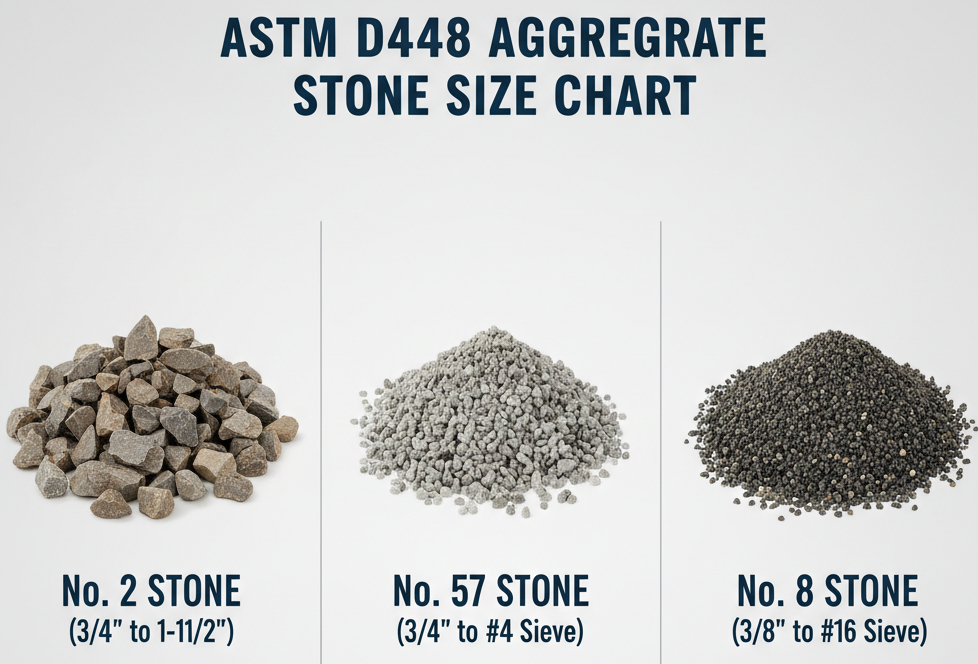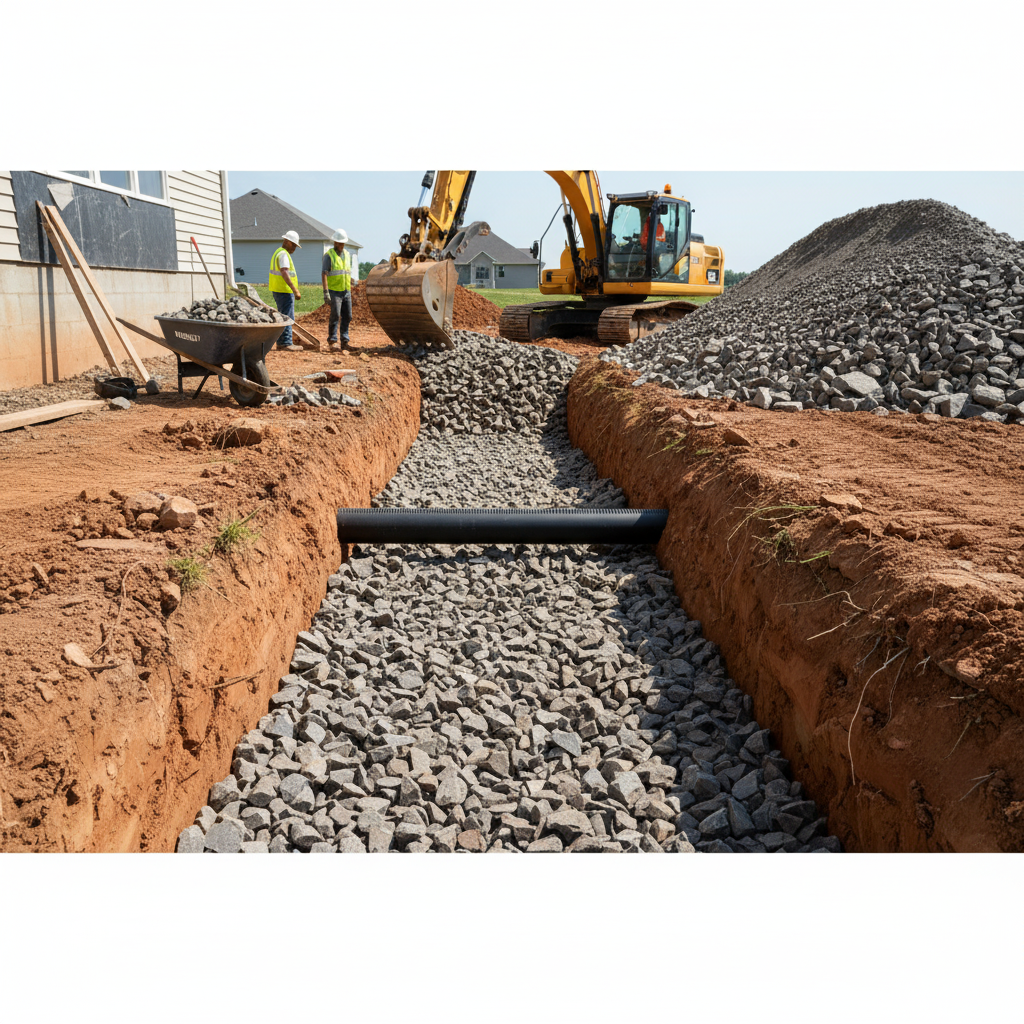ASTM D448: Aggregate Size Classification
Standard Classification for Sizes of Aggregate for Road and Bridge Construction
Last updated: November 5, 2025
Overview
ASTM D448 establishes a numerical system for classifying sizes of coarse aggregate and screenings based on their gradation (particle size distribution) as determined by sieve analysis. While its title suggests civil infrastructure use, its standardized size designations (e.g., No. 57 stone, No. 8 stone) have been broadly adopted across the construction industry for various applications including building construction and site work.
Quick Reference Guide
Most commonly specified stone sizes and their uses:

Visual comparison of the three most common ASTM D448 stone sizes
No. 57 Stone
3/4" to 1"
• Drainage systems
• Concrete aggregate
• French drains
• Septic systems
No. 8 Stone
3/8" to 1/2"
• Bedding layer
• Exposed aggregate
• Pervious concrete
• Decorative surfaces
No. 2 Stone
1 1/2" to 2 1/2"
• Subbase layer
• Water storage
• Stable base
• Heavy equipment
Complete Stone Size Table
ASTM D448 size designations and typical size ranges:
| Size Number | Typical Size Range | Common Applications |
|---|---|---|
| No. 1 | 2 1/2" to 4" | Large riprap, erosion control, large drainage |
| No. 2 | 1 1/2" to 2 1/2" | Subbase, permeable pavement base, large drainage |
| No. 24 | 1 1/2" to 1" | Railroad ballast, heavy drainage applications |
| No. 3 | 1" to 2" | Railroad ballast, coarse drainage, riprap |
| No. 357 | 1 1/2" to No. 4 | Drainable base, coarse drainage layers |
| No. 4 | 1" to 1 1/2" | Drainage layers, coarse aggregate for concrete |
| No. 467 | 3/4" to No. 4 | Concrete aggregate, drainage |
| No. 5 | 3/4" to 1" | Road base, general drainage |
| No. 56 | 1/2" to 3/4" | Road surfacing, intermediate drainage |
| No. 57 | 3/4" to 1" | Drainage systems, concrete aggregate, french drains |
| No. 6 | 1/2" to 3/4" | Road base, concrete aggregate |
| No. 67 | 3/4" to No. 4 | Concrete aggregate, surface applications |
| No. 68 | 1/2" to No. 8 | Concrete aggregate, surface course |
| No. 7 | 1/4" to 1/2" | Fill material, asphalt aggregate |
| No. 78 | 1/2" to No. 200 | Surface course, hot mix asphalt |
| No. 8 | 3/8" to 1/2" | Bedding layer for pavers, exposed aggregate, permeable surface |
| No. 89 | 3/8" to No. 16 | Concrete mix, asphalt mix, surface course |
| No. 9 | 1/8" to 3/8" | Concrete aggregate, fill applications |
| No. 10 | No. 4 to dust | Screenings, leveling course, compactable base |
Note: Size ranges are approximate and based on sieve analysis per ASTM D448. Actual gradation requirements include specific percentages passing through standard sieve sizes. Always verify with the complete ASTM D448 specification for your jurisdiction.
Which Size Do I Need?
Select the right aggregate size for your project:
For Drainage Systems
Use No. 57 stone (3/4" to 1") - Open grading allows water flow while providing structural support. Perfect for French drains, foundation drainage, and septic drain fields.

No. 57 stone being used for pavement base - ideal for drainage and structural support
For Concrete Mix
Use No. 67 stone (1/4" to 3/4") - Standard size for ready-mix concrete. Also good for No. 8 stone (3/8" to 1/2") in pervious concrete applications.
For Base Course / Subbase
Use No. 2 stone (1 1/2" to 2 1/2") - Large, stable aggregate that holds up under heavy equipment. High water storage capacity makes it ideal for permeable pavement subbase.

No. 2 stone as subbase layer - provides stability under heavy loads and high water storage
For Erosion Control
Use No. 3 stone (1" to 2") or No. 1 stone (2 1/2" to 4") - Large riprap that resists water flow and protects slopes. Also used in gabion walls and infiltration trenches.
For Decorative / Exposed Surfaces
Use No. 8 stone (3/8" to 1/2") or No. 89 stone (1/8" to 3/8") - Smaller aggregates suitable for exposed aggregate finishes, decorative paths, and landscape applications.

No. 8 stone for landscaping and decorative applications - perfect for walkways and exposed surfaces
Permeable Pavement Applications
For permeable interlocking concrete pavement (PICP) systems, ASTM D448 is critical. The performance depends entirely on void space within aggregate layers. Open-graded aggregates like No. 57 stone ensure high percentages of interconnected voids, allowing stormwater to pass through freely and be stored in the subbase. Well-graded aggregates with mixed particle sizes would create dense, non-permeable bases unsuitable for drainage.
Frequently Asked Questions
What is No. 57 stone used for?
No. 57 stone (3/4" to 1") is one of the most popular aggregate sizes. It's used for drainage applications like French drains, foundation drainage, and septic drain fields because the open grading allows water to flow freely while providing structural support. It's also used as concrete aggregate and in permeable pavement base layers.
What's the difference between No. 8 and No. 57 stone?
No. 8 stone is smaller (3/8" to 1/2") compared to No. 57 stone (3/4" to 1"). No. 8 is used for bedding layers under pavers, exposed aggregate finishes, and pervious concrete. No. 57 is larger and better for drainage systems and base layers. The smaller No. 8 stone "chokes" into No. 57 base layers to create a stable, permeable system.
What size stone do I need for a French drain?
Use No. 57 stone (3/4" to 1") for French drains. This size provides the best balance of water flow and structural support. The open grading prevents clogging while allowing water to move freely through the drain pipe system. Avoid using smaller stones or pea gravel, as they can compact and reduce drainage effectiveness.
How do I identify what stone size I have?
Measure the stones with a ruler. Most stones fall within a range, so look at several pieces. No. 57 stones are roughly 3/4" to 1" (about the size of a large grape). No. 8 stones are about 3/8" to 1/2" (marble-sized). No. 2 stones are 1 1/2" to 2 1/2" (baseball to softball sized). See the visual comparison chart above in the Quick Reference section for a side-by-side view. If you have paperwork from your aggregate supplier, check for ASTM D448 size designations.
Can I use No. 2 stone for drainage?
No. 2 stone (1 1/2" to 2 1/2") is typically too large for most residential drainage applications. It's better suited as a subbase layer under permeable pavements where you need high water storage capacity and stability under heavy equipment. For drainage, No. 57 stone is the better choice. No. 2 works well underneath No. 57 in layered systems.
What's the difference between ASTM D448 and ASTM C33?
ASTM D448 classifies aggregate sizes for road and bridge construction by gradation (size distribution). ASTM C33 specifies concrete aggregates and includes not just size requirements but also durability, hardness, and particle shape requirements. For concrete projects, you often need aggregates that meet both standards: "No. 57 stone per ASTM D448 meeting durability requirements of ASTM C33."
Complete Specification Requirements
While D448 provides clear gradation definitions, it doesn't specify other important properties like hardness, durability, or particle shape. For demanding applications like permeable pavements subject to vehicular traffic, specifications must be augmented: "Base aggregate shall be crushed stone conforming to gradation requirements of ASTM D448, Size No. 57, and shall meet durability requirements of ASTM C33." This ensures correct particle size distribution for permeability plus necessary toughness for long-term structural support.
How to Order the Right Stone
Ask for: "ASTM D448, Size No. [number]" when calling suppliers
Example: "I need No. 57 stone per ASTM D448 for a French drain - about 5 tons"
For engineered projects: Include additional requirements like "meeting ASTM C33 for durability"
Verify before delivery: Ask supplier to confirm the size number matches your application needs
Official Resources
For complete aggregate specifications and testing requirements:
ASTM International
Official ASTM D448 standard document (purchase required for complete gradation tables and specifications)
ASTM C33
Concrete aggregate specifications (includes durability and hardness requirements often specified alongside D448)
Local Availability: Contact your local aggregate suppliers for specific D448 sizes available in your area. Not all sizes are stocked by every supplier. Ask for "ASTM D448 No. [size number]" when ordering to ensure you get the correct gradation.
Was this resource helpful?
Your feedback helps us improve our technical resources and guides.